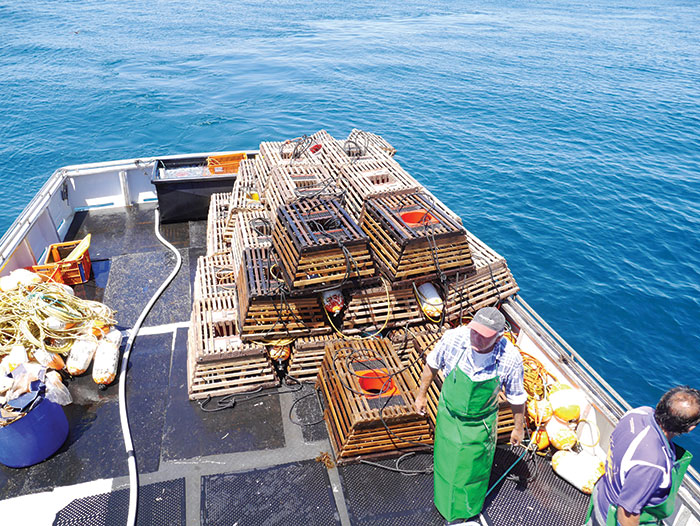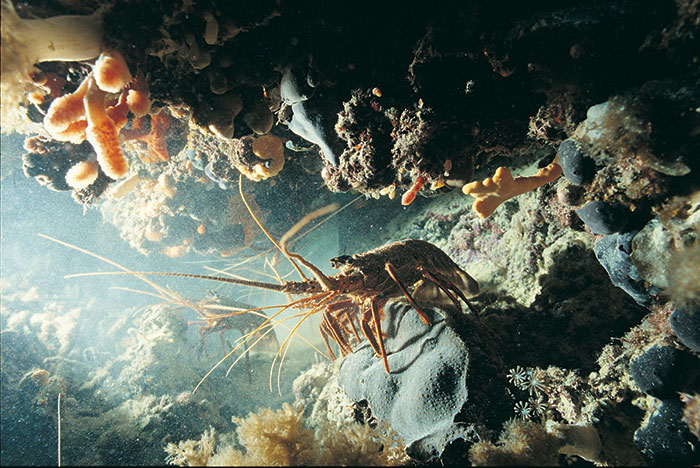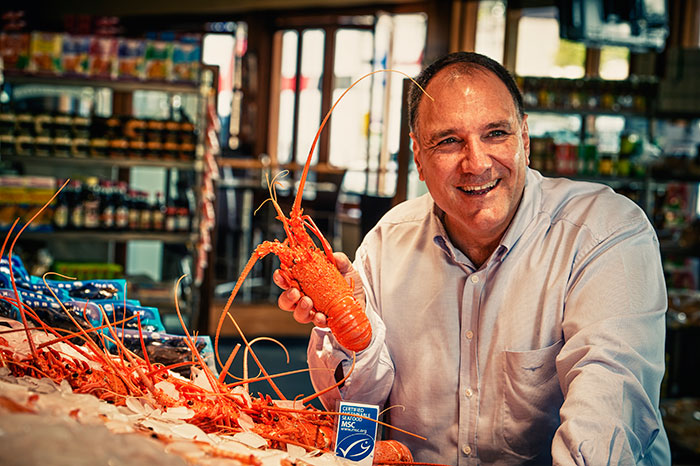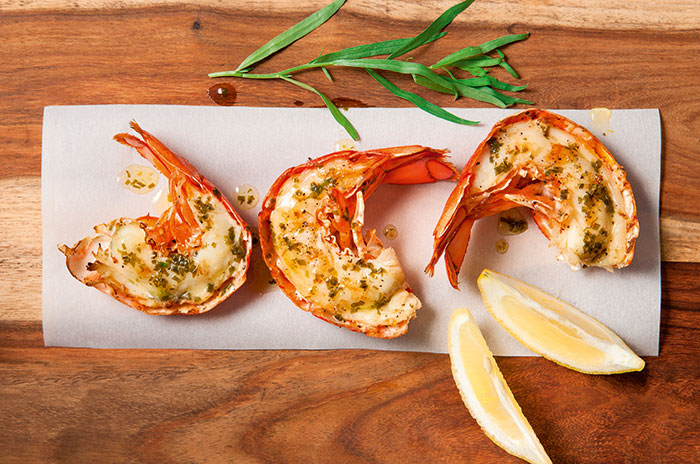Close to collapse only six years ago, WA’s rock lobster fishery is now bigger than it was in the 1960s, thanks to decisive and timely action
The dark days for the lobster industry began in 2008, when Department of Fisheries researchers reported the lowest juvenile lobster settlement in the fishery's history. Today, the commercial lobster industry is booming, based on half its previous take. It earns the state around $350 million a year in export income, and estimates capitalise it at $3 billion. (The recent free trade agreement with China is good news for the commercial lobster industry.) This year, there are a record 40,000 licensed recreational lobster fishers. So, how did things turn around so quickly?
For more than 20 years, researchers have accurately predicted the size of the lobster catches four years in advance by monitoring juvenile lobster (or puerulus) settlement. Six years ago they envisaged a train wreck in the making. The good news was that the industry had four years to do something about it.
Basil Lenzo, a third-generation Fremantle professional fisherman, a director of the Western Rock Lobster Council and of Geraldton Fishermen's Co-operative, the state's largest lobster processor, remembers when the first-year summary of low puerulus count came out.
"I wasn't that concerned. But when the second year was also low, I was very concerned, and by the third year of poor count I was devastated, and our asset price had dropped to a third," he recalls.
The first woman chair of the Western Rock Lobster Council, Linda Williams, looks back and remembers not only the shock but also the deep anguish it brought. The wife of Art, a Lancelin lobster professional fisherman for 30 years, and mother to Chris, who's also a lobster fisherman, she had reason to be worried.

"What was the future?" she says was the question at the forefront of everyone's minds. "Because fishing is not just a job, it's a way of life, and the viability of many coastal communities rested on the lobster industry." We had never encountered anything like this. We had our ups and downs in the four-year cycles, but when the scientists starting talking no puerulus... well, some were sceptical – it just
wasn't real, and then it was shock and disbelief that it was happening."
The state government acknowledged the results of the department's research and management advice, and, supported by a majority of the industry, took strong, swift action.
Over the following two years, the catch was cut by half, to allow the stock to build up its biomass, ensuring there was plenty of breeding stock and enough animals left in the water for the years ahead. This meant the commercial fishery could remain open, albeit at reduced capacity. In 2010, a quota management system was introduced.
The quota management regime set a total allowable catch. It was no longer a question of catching as many lobster as you could; fishermen could only catch according to the quota allocated to each of the individual pots they owned.
Industry effort was no longer limited by a seven-month season, and, by 2013, fishers could fish all year. The challenge now was to fish to market in order to maximise return on less volume.
For some, the quota was devastating, making their businesses unviable. Even among those who could afford to stay, there was vigorous opposition to the changes.
.jpg)
Dr Simon de Lestang, with the kind of puerulus collector used to monitor lobster populations.
"We lost 200 fishermen virtually overnight, and when you count an average of two crew for each, it was 600 people out of a job," says Basil. "It was a tragedy for many in the industry."
Both Basil and Linda say it was then-Fisheries Minister Norman Moore's decisive action that dramatically contained the damage and set the foundations for today's flourishing industry.
The average annual catch before 2008 was around 11,000 tonnes, and that was cut to 5500 tonnes. This year's total allowable catch is 5859 tonnes; next year's will be 6000 tonnes.
When the crisis struck, pot prices plummeted to between $9000 and $14,000, following the historical average from the mid 1990s of about $25,000; today it ranges between $40,000 and $50,000. The average beach price per kilo for fishers in 2008 was $35 to $40; this year it is $60.
In 2000, the lobster fishery became the first in the world to gain the Marine
Stewardship Council's (MSC) tick as a well-managed and sustainable fishery – so how did one of the best-managed fisheries in the world nearly fall over?
Department of Fisheries researchers can predict the size of the lobster fishery four years ahead by counting the puerulus attached to a puerulus collector, which is made of artificial seaweed and looks like a giant bottlebrush.
These puerulus are tiny, transparent lobsters measuring a mere 25mm that are swimming back to the coast to make their new home on the reefs where they routinely grow and moult for around four years before reaching legal size – hence
the four-year prediction window. Collectors are placed in 10 locations along the coast from Coral Bay to Margaret River, and monitored monthly.
"At the height of the crisis, we were counting just one puerulus, when the traditional average was 100," says Dr Simon de Lestang, Department of Fisheries, principal research scientist, Western Rock Lobster. "In some sites we averaged just 0.2 across the five collectors.

More than $3 million was quickly invested into six major Department of Fisheries research projects in partnership with Fisheries Research and Development Corporation (FRDC), CSIRO, UWA and Murdoch University. The projects included working alongside the weather bureau to match patterns in the weather with the lobster's complex life cycle, and research into the life of lobster larvae, which can't swim but drift in the ocean for 11 months, up to 1500km off shore, and are totally dependent on environmental forces.
"The Department was under a lot of pressure, and the MSC provided an independent, international peer review, and supported the measures we were recommending. It helped gain public approval and gave us confidence," says Dr de Lestang. "The most likely cause of the low count was a shift in the timing of spawning by the lobster of almost a month, and a change in water temperature.
"We know water temperatures affect spawning. Ocean-floor water temperatures on the shelf used to be coolest in October, and recently it has been coolest in August, and warming up earlier.
"Traditional settlement patterns have not entirely returned, but because far less lobster is being harvested, the levels of lobster in the water are the best they have been in years.
"Quota management is very good for this fishery," he explains. "The lobster stay in the same location and have a relatively long lifespan, so the lobster you leave in the water today can continue to grow at no cost, and be caught tomorrow, or next season, to fit what the market is demanding at any given time."
The MSC Australia and New Zealand manager, Pat Caleo, remembers the period well. "In 2010, the MSC brought our London-based standards director, Andrew Mallison, to Perth, with Australian-based board member Dr Keith Sainsbury, for a conference to publically support the industry and the management decisions that had been made to maintain their certification.
"At that time, it was important to highlight that the management of wild fisheries is a task of constant vigilance and flexibility – the crucial element is reacting quickly when things change, so that the fishery can continue to operate sustainably.
"The WA Government, fishery management and industry showed tremendous leadership and initiative to ensure the sustainability of the fishery, and that's why it retained MSC certification through the troubled times," says Pat.
For Kailis Bros Leederville's Theodore Kailis, whose family has been selling seafood to Perth consumers for 88 years, and marketing lobster internationally since the mid 70s, the crisis has led to a greater regard for every animal taken out of the water. "It has permeated the whole supply chain – it's not just a commodity," he says. "For the last five years our industry has been driven by robust live export to China, which has an almost insatiable appetite for Western Australian lobster."

Theodore Kailis' family has been marketing lobster to Perth buyers since the 1970s.
In the domestic market, high export demand has driven the local lobster price to $90/kg. In the Oxford Street fish market there is a photograph, taken in 1936, of Theodore's grandfather George's first shop in Barrack Street. On the window is painted 'Crays 4 shillings a pound'. How things have changed... but while the price of lobster is high, people are still buying.
"People are combining and balancing luxury and price, to deliver a dining experience and value," says Theo. "So it's no longer just a lobster salad – it's a seafood paella or spaghetti marinara that includes lobster."
The local lobster abundance is also good news for recreational fishers, who have a longer season, larger bag limit, and other measures to help them catch more of their share of the lobster resource. The recreation and commercial share is set as part of the Department's resource access process, which establishes how much of the total lobster resource needs to be retained in the water for the health of the fishery and breeding. What's left is the 'maximum economic harvest' – from this, recreational and commercial shares are allocated five per cent and 95 per cent respectively.
Dr Andrew Rowland, CEO of Recfishwest, represents about 740,000 Western Australians who fish every year; a record 40,000 of them have bought a licence to catch their own lobster. "Sustainability is always our number-one priority, but now they're more accessible and easier to catch," says Dr Rowland. "Our primary catching time is in the lead-up to Christmas – it gives recreational fishers the chance to throw in their pots and catch some lobster at a time when the annual
closure for fish like dhufish, pink snapper and baldchin groper occurs."
Fisheries Minister Ken Baston led an industry delegation to China just prior to the G20 last November. Western Rock Lobster Council CEO John McMath was part of the delegation, and says he left with the impression that China values our seafood highly and wants to build on the existing relationship, and that there are exciting times ahead for the industry.
"It is hoped that the FTA will remove the first level of import duties on lobster – similar to the FTA New Zealand has with China," he says. "But most importantly, it will provide greater transparency of the trade and a strong base for long-term development."
For more information, visit wamsc.com.au or fish.wa.gov.au.

COOKING YOUR LOBSTER
Theodore Kailis gives his tips for preparing the best dish.
If the lobster is alive you must gently put it to sleep, to ensure the animal is dead before you cook it. You can do this by immersing it in fresh water, or put it in the freezer for at least 30 minutes.
Cook six average-sized lobsters in well-salted boiling water for 16 minutes. Make sure the lobsters are completely covered by the water. Cooking time may vary slightly depending on the size of the animal, the intensity of the hot plate and the number of lobsters you have in the pot. It's crucial to fully immerse the cooked lobster in ice-water slurry immediately after you take it from the pot, to stop the cooking process.
For more information on how to cook lobsters, and all seafood, visit fishfiles.com.au.
WHAT'S IN A NAME?
While traditionally in WA they've been called crayfish or crays, the official name for these creatures is Western Rock Lobster.
For the commercial industry, the name Western Rock Lobster was proclaimed by the WA Parliament in 1969 in a response to French efforts to have our crayfish named 'crawfish', which the industry thought would be easily confused on the international market with the little, far less valuable American crawfish, and would devalue the international export trade.
In more recent years, the Fisheries Research and Development Corporation (FRDC) has funded the establishment of the Australian Fish Names list which sets a standard for each species of fish produced or traded in Australia. It settles the argument – it's Western Rock Lobster.
For more information, visit fishnames.com.au.